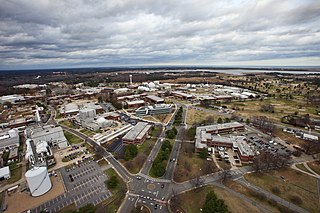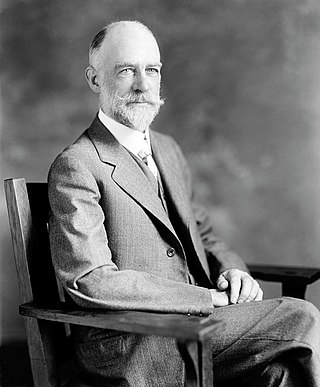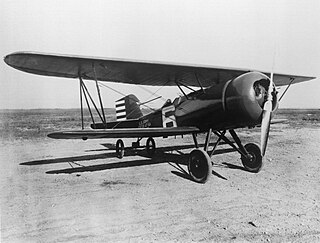
The National Advisory Committee for Aeronautics (NACA) was a United States federal agency founded on March 3, 1915, to undertake, promote, and institutionalize aeronautical research. On October 1, 1958, the agency was dissolved and its assets and personnel were transferred to the newly created National Aeronautics and Space Administration (NASA). NACA is an initialism, i.e., pronounced as individual letters, rather than as a whole word.

The Robert J. Collier Trophy is an annual aviation award administered by the U.S. National Aeronautic Association (NAA), presented to those who have made "the greatest achievement in aeronautics or astronautics in America, with respect to improving the performance, efficiency, and safety of air or space vehicles, the value of which has been thoroughly demonstrated by actual use during the preceding year."

The Langley Research Center, located in Hampton, Virginia near the Chesapeake Bay front of Langley Air Force Base, is the oldest of NASA's field centers. LaRC has focused primarily on aeronautical research but has also tested space hardware such as the Apollo Lunar Module. In addition, many of the earliest high-profile space missions were planned and designed on-site. Langley was also considered a potential site for NASA's Manned Spacecraft Center prior to the eventual selection of Houston, Texas.

Robert Rowe Gilruth was an American aerospace engineer and an aviation/space pioneer who was the first director of NASA's Manned Spacecraft Center, later renamed the Lyndon B. Johnson Space Center.

The NASA X-43 was an experimental unmanned hypersonic aircraft with multiple planned scale variations meant to test various aspects of hypersonic flight. It was part of the X-plane series and specifically of NASA's Hyper-X program. It set several airspeed records for jet aircraft. The X-43 is the fastest jet-powered aircraft on record at approximately Mach 9.6.

The Bell X-14 is an experimental VTOL aircraft flown in the United States in the 1950s. The main objective of the project was to demonstrate vectored thrust horizontal and vertical takeoff, hover, transition to forward flight, and vertical landing.

William Frederick Durand was a United States naval officer and pioneer mechanical engineer. He contributed significantly to the development of aircraft propellers. He was the first civilian chair of the National Advisory Committee for Aeronautics, the forerunner of NASA.

Abraham "Abe" Silverstein was an American engineer who played an important part in the United States space program. He was a longtime manager at the National Aeronautics and Space Administration (NASA) and its predecessor, the National Advisory Committee for Aeronautics (NACA). He was instrumental in the planning of the Apollo, Ranger, Mariner, Surveyor, and Voyager missions, and named the Apollo program after the Greek and Roman God.

The NACA cowling is a type of aerodynamic fairing used to streamline radial engines installed on airplanes. It was developed by Fred Weick of the National Advisory Committee for Aeronautics (NACA) in 1927. It was a major advance in aerodynamic drag reduction, and paid for its development and installation costs many times over due to the gains in fuel efficiency that it enabled.

The Curtiss P-6 Hawk is an American single-engine biplane fighter introduced into service in the late 1920s with the United States Army Air Corps and operated until the late 1930s prior to the outbreak of World War II.

The Curtiss F6C Hawk was a late 1920s American naval biplane fighter aircraft. It was part of the long line of Curtiss Hawk airplanes built by the Curtiss Aeroplane and Motor Company for the American military.
Gustav Victor Lachmann was a German aeronautical engineer who spent most of his professional life working for the British aircraft company Handley Page. He was, with Frederick Handley Page, the co-inventor of the leading edge slot.

The Grumman XSBF, also known by the company designation G-14, was an American biplane scout bomber developed by Grumman Aircraft for the United States Navy during the 1930s. Derived from Grumman's successful "Fifi" fighter, the aircraft was developed at a time when the biplane was giving way to the monoplane. In competition against other aircraft it proved to possess inferior performance in its intended role, and did not enter production. The sole prototype went on to serve as a liaison aircraft, as well as being used in experiments by NACA, before being destroyed in a crash in 1939.

The Vought XSB3U was an American biplane scout bomber developed by Vought-Sikorsky for the United States Navy during the 1930s. Developed as an alternative to the SB2U Vindicator monoplane, the aircraft proved unsatisfactory to the Navy in comparison, and development was not pursued.

The Meredith effect is a phenomenon whereby the aerodynamic drag produced by a cooling radiator may be offset by careful design of the cooling duct such that useful thrust is produced by the expansion of the hot air in the duct. The effect was discovered in the 1930s and became more important as the speeds of piston-engined aircraft increased over the next decade.

The Consolidated XB2Y was an American prototype single-engined dive bomber of the 1930s. It was intended to meet a United States Navy requirement for a carrier-based dive bomber, but was unsuccessful, only a single example being built.
William H. "Bill" McAvoy was a civilian test pilot in the 1920s and 1930s for the National Advisory Committee for Aeronautics (NACA) at the Langley Memorial Aeronautical Laboratory, Langley Field, Virginia, and in 1940 helped start the flight operations division at the Ames Research Center, California.
Germaine Schneider was a Belgian communist and Communist International (Comintern) agent. During the latter half of the 1920s, Schneider worked predominantly for the Communist Party of Belgium. During the interwar period and early World War II, Schneider was a core member of a Soviet espionage group. She worked as a principal courier for the groups that were associated with the Comintern agent, Henry Robinson in the late 1930s in France and later the Soviet GRU officer, Konstantin Jeffremov in Belgium and the Low Countries, in the early 1940s. These groups were later identified by the Abwehr under the moniker the Red Orchestra. Schneider used the aliases Clais, Pauline, Odette, Papillon and Butterfly (Schmetterling) to disguise her identity.

Ernest David Weiss was a naturalised British Jewish transport economist who became a Soviet espionage agent, spying in the United Kingdom and possibly the United States. Weiss worked initially for the Communist International (Comintern) in the 1930s and later worked for the Red Orchestra espionage network through Comintern agent Henry Robinson in the early 1940s. In 1947, Weiss's name was discovered through an analysis of the Robinson papers by MI5. After his arrest and interrogation, Weiss proved to be remarkably cooperative, and in return for a confession he was promised immunity by MI5. He was found to have been a key individual in Soviet intelligence in the United Kingdom during the interwar period but has ceased workiing as an agent in 1941. He named many other contacts, and this led to further arrests. Weiss's cryptonym was Jean. After his confession, he retired from espionage work to work as part of piano double act that played in variety shows, music halls and theatres that regularly toured the uk. He lived in London until his death in 1982.
















